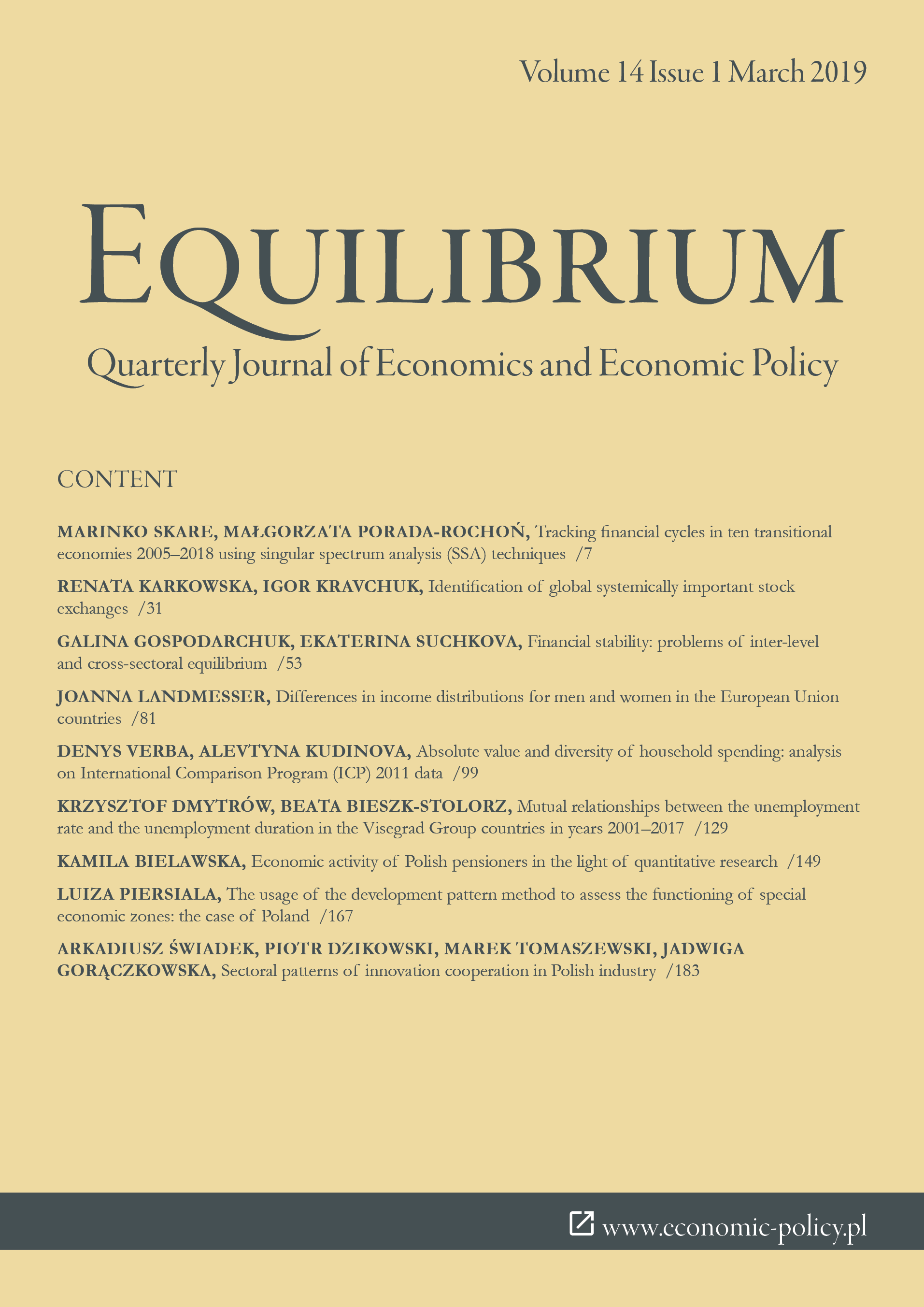Mutual relationships between the unemployment rate and the unemployment duration in the Visegrad Group countries in years 2001?2017
DOI:
https://doi.org/10.24136/eq.2019.006Keywords:
registered unemployment rate, unemployment duration, business cycle clock, Dynamic Time Warping, Visegrad Group countriesAbstract
Research background: The most important indicators that describe the situation on the labour market are the unemployment rate and the unemployment duration. If both these indicators are high, then the human capital deteriorates. Therefore, it seems justified to analyse the mutual relationships between them.
Purpose of the article: The article aims at finding the relationships between the unemployment rate and the unemployment duration, and checking if the mutual courses of these two indicators in the Visegrad Group countries are connected with each other.
Methods: The business cycle clock methodology will be used to analyse the relationship between the unemployment rate and the median unemployment duration. Next, the similarity of the course of these two indicators will be analysed by means of the Pearson product-moment correlation coefficient and the Dynamic Time Warping (DTW) technique.
Findings & Value added: Amongst the analysed countries, Czechia, Poland and Slovakia were, to a certain degree, similar with respect to the mutual course of the unemployment rate and the unemployment duration. Until the peak of the financial crisis in 2009, the unemployment rate and the unemployment duration decreased. During the next years, the unemployment rate was increasing and after 2-3 years it was followed by the increase of the unemployment duration. The situation improved after the year 2013 ? both indicators were decreasing. In Hungary, on the contrary, the unemployment rate was increasing or steady until 2012, and during the following years it started to decrease. However, the course of the unemployment duration was completely different than in remaining countries. The value added of the article is application of the business clock cycle and the Dynamic Time Warping technique in finding the relationships and similarity of courses between the unemployment rate and the unemployment duration.
Downloads
References
Abberger, K., & Nierhaus, W. (2010). The Ifo business cycle clock: circular correlation with the real GDP. CESifo Working Paper, 3179.
DOI: https://doi.org/10.2139/ssrn.1681322
View in Google Scholar
Abraham, K. G., & Shimer, R. (2001). Changes in unemployment duration and labor force attachment. NBER Working Paper Series, 8513. doi: 10.3386/w 8513.
DOI: https://doi.org/10.3386/w8513
View in Google Scholar
Bieszk-Stolorz, B., & Markowicz, I. (2014). Relationship between duration of job seeking and receiving unemployment benefit. Search theory on labour market. Acta Universitatis Lodziensis. Folia Oeconomica, 3(302).
View in Google Scholar
Chocholatá, M., & Furková, A. (2018). The analysis of employment rates in the context of spatial connectivity of the EU regions. Equilibrium. Quarterly Journal of Economics and Economic Policy, 13(2). doi: 10.24136/eq.2018.010.
DOI: https://doi.org/10.24136/eq.2018.010
View in Google Scholar
Furuoka, F. (2014). Hysteresis effect on unemployment: evidence from the Visegrad Countries. Ekonomický časopis, 62(2).
DOI: https://doi.org/10.2298/PAN1505631F
View in Google Scholar
Giorgino, T. (2009). Computing and visualizing dynamic time warping alignments in R: the dtw package. Journal of Statistical Software, 31(7). doi: 10.18637/jss. v031.i07.
DOI: https://doi.org/10.18637/jss.v031.i07
View in Google Scholar
Hadaś-Dyduch, M., Pietrzak, M. B., & Balcerzak, A. P. (2016). Wavelet analysis of unemployment rate in Visegrad countries. In T. Kliestik (Ed.). 16th international scientific conference globalization and its socio-economic consequences. University of Zilina, The Faculty of Operation and Economics of Transport and Communication, Department of Economics, 5th – 6th October 2016. (Part II.). Zilina: University of Zilina.
View in Google Scholar
Kwiatkowski, E. (2011). Recent labour market trends in the Visegrad Group countries. Comparative Economic Research, 14(2). doi: 10.2478/v10103-011-0009-z.
DOI: https://doi.org/10.2478/v10103-011-0009-z
View in Google Scholar
Meyer, B. D. (1990). Unemployment insurance and unemployment spells. Econometrica, 58(4). doi:10.2307/2938349.
DOI: https://doi.org/10.2307/2938349
View in Google Scholar
Mortensen, D. T. (1970). Job search, the duration of unemployment, and the Phillips curve. American Economic Review, 60(5).
View in Google Scholar
Mortensen, D. T. (1977). Unemployment insurance and job search decisions. Industrial and Labor Relations Review, 30(4). doi:10.2307/2523111.
DOI: https://doi.org/10.2307/2523111
View in Google Scholar
Mukoyama, T., & Şahin A. (2004). Why did the average duration of unemployment become so much longer? Federal Reserve Bank of New York Staff Reports, 194.
DOI: https://doi.org/10.2139/ssrn.596621
View in Google Scholar
Nickell, S. (1979). The effect of unemployment and related benefits on the duration of unemployment. Economic Journal, 89(353). doi: 10.2307/2231405.
DOI: https://doi.org/10.2307/2231405
View in Google Scholar
Pilc, M. (2015). Determinants of the labour market institutions in post-socialist economies. Communist and Post-Communist Studies, 48(2-3). doi: 10.1016/j. postcomstud.2015.06.008.
DOI: https://doi.org/10.1016/j.postcomstud.2015.06.008
View in Google Scholar
Rollnik-Sadowska, E., & Dąbrowska, E. (2018). Cluster analysis of effectiveness of labour market policy in the European Union. Oeconomia Copernicana, 9(1). doi: 10.24136/oc.2018.008.
DOI: https://doi.org/10.24136/oc.2018.008
View in Google Scholar
Szymczak, A., & Gawrycka, M. (2013). Labour share in the domestic income compared to different labour markets. Przedsiębiorstwo we współczesnej gospodarce – teoria i praktyka / Research on Enterprise in Modern Economy – theory and practice, 4.
View in Google Scholar
Tvrdon, M. (2011). Unemployment as the macroeconomic problem: the case of Visegrad Group countries. International Journal of Systems Applications, Engineering & Development, 2(5).
View in Google Scholar
Zieliński, M. (2018). Effect of the economic situation on employment and its structure in the Central and Eastern European countries. Ekonomia i Prawo. Ecomomics and Law, 17(3). doi: 10.12775/EiP.2018.024.
DOI: https://doi.org/10.12775/EiP.2018.024
View in Google Scholar






